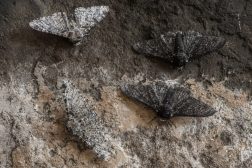Table of Contents
Moth Definition
A moth is a lepidopteran insect. Moths belong to the Order Lepidoptera, together with the butterflies. There are approximately 160,000 moth species worldwide. In the United States, there are approximately 11,000 moth species. (Ref. 1) In general, the lepidopterans differ from other insects in having scale covering on their wings and having a proboscis that coils when the insect is at rest and then extends when it feeds or “sips”. Many moths are nocturnal. They gather nectar from flowers at night. (Ref. 1) Many of the nocturnal moths have dull wing colors. The diurnal moths, in contrast, are brightly colored. An example of a day-flying moth with spectacular wing colors is the six-spot burnet moth (scientific name: Zygaena filipendulae). Similar to other insects, the typical life stages of moths are as follows: egg » caterpillar » pupa » adult. The egg that is laid on the plant will hatch and develop into a caterpillar (a lepidopteran larva). The larval stage of a lepidopteran will spend most of its time feeding and growing its size. When it has fully grown, it will turn into a pupa. Most moth pupae are protected inside a silk cocoon. The pupa develops into an adult with features that are significantly different from the larval stage. For instance, The adult moth develops wings for flying to places. Moths and butterflies undergo a complete type of metamorphosis. (Ref. 2) As for evolutionary history, moths may have existed before butterflies. In one study, researchers conjectured that butterflies may have originated from a single common moth ancestor based on their genetic analysis. (Ref. 3)

Etymology
The term moth came from the Old English “moþþe”. It is likely related to the Old English “maða”, meaning “maggot”.
Differences Between Butterflies and Moths
Both moths and butterflies are lepidopterans. They have a pair of scaly wings and a proboscis that they can coil and extend. They also undergo the same life stages and a complete type of metamorphosis. Despite these similarities, there are morphological distinctions to identify one from the other. For instance, most moths have unclubbed antennae that are threadlike or feathery as opposed to butterflies that have clubbed tips on their slender antennae.
Importance of Moths
Significance to humans
Some moth larvae are regarded as agricultural pests, e.g. corn borers, sugarcane borers, and bollworms. Many moth caterpillar species in the family Tineidae are also regarded as pests for being notorious for eating clothing. In some parts of the world, e.g. Africa and Asia, some caterpillars are harvested for human consumption.
Predators
Nocturnal moths are preyed on by nocturnal insectivores, such as certain bats, birds, and owls. Other predators of moths are amphibians, lizards, and rodents.
Ecological importance
Moths are important pollinators of many plants. As they sip nectar from these flowers they tend to transfer pollen from the anther to the stigma of flowers.
Attraction to Light
Moths exhibit positive phototaxis. They tend to fly toward the light source. The reason for this behavior is still unclear. One possible explanation is the dorsal light reaction. The moth senses the direction of the light source and flies in a way that the light direction is overhead or on its dorsal side. This behavior may be of help to the insect to stay parallel to the ground. (Ref. 4)
References
- Moths. (2020). Smithsonian Institution. https://www.si.edu/spotlight/buginfo/moths
- Butterfly Life Cycle. (2018). Ansp.Org. https://ansp.org/exhibits/online-exhibits/butterflies/lifecycle/
- Yirka, B. (2014, June 25). DNA analysis reveals butterfly and moth evolutionary relationship. Phys.Org; Phys.org. https://phys.org/news/2014-06-dna-analysis-reveals-butterfly-moth.html
- CK-12 Foundation. (2015, December 11). Insect Behavior. CK-12 Foundation; CK-12 Foundation. https://www.ck12.org/biology/insect-behavior/lesson/Insect-Behavior-Advanced-BIO-ADV/
©BiologyOnline. Content provided and moderated by BiologyOnline Editors.



